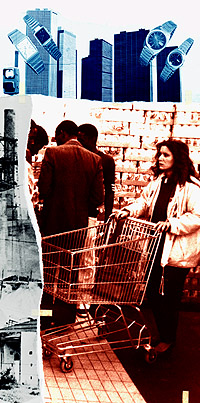
Moving clockwise from top, the images are 1: China, 1987: Advertising in Beijing streets (Peter Williams /WCC); 2: Mozambique: Foreign currency shop in Maputo (Peter Williams /WCC); 3: Industry (WCC).
A kind
Early postwar hopes for a new world order, with international institutions like the United Nations and the WCC playing a central role in overcoming past divisions, were often disappointed during the forty years of cold war which followed. Meanwhile, more and more voices were reminding the churches of a perhaps even deeper division in the human family -- that between the North and the South.
With the end of the cold war in the early 1990s came renewed talk of a new world order, fuelled by the triumph of the market economy over socialist systems. The "one world" came more and more to be seen in terms of one market.
To this "globalization", the WCC has raised critical challenges. A text from the Central Committee in 1997 points to a sharp divergence between two visions of unity:
of global
unity
The experiences of the second world war made it obvious to the Amsterdam assembly that the divisions of the world often divide the church as well. In working for their own unity, churches must address not only traditional theological disagreements but also these divisions.
The emergence of transnational and increasingly worldwide structures of communication, finance and economy has created a particular kind of global unity. The cost of this has been growing fragmentation of societies and exclusion for more and more of the human family. This constitutes a serious threat to the integrity of the ecumenical movement, which represents a distinctly different model of relationships, based on solidarity and sharing, mutual accountability and empowerment.